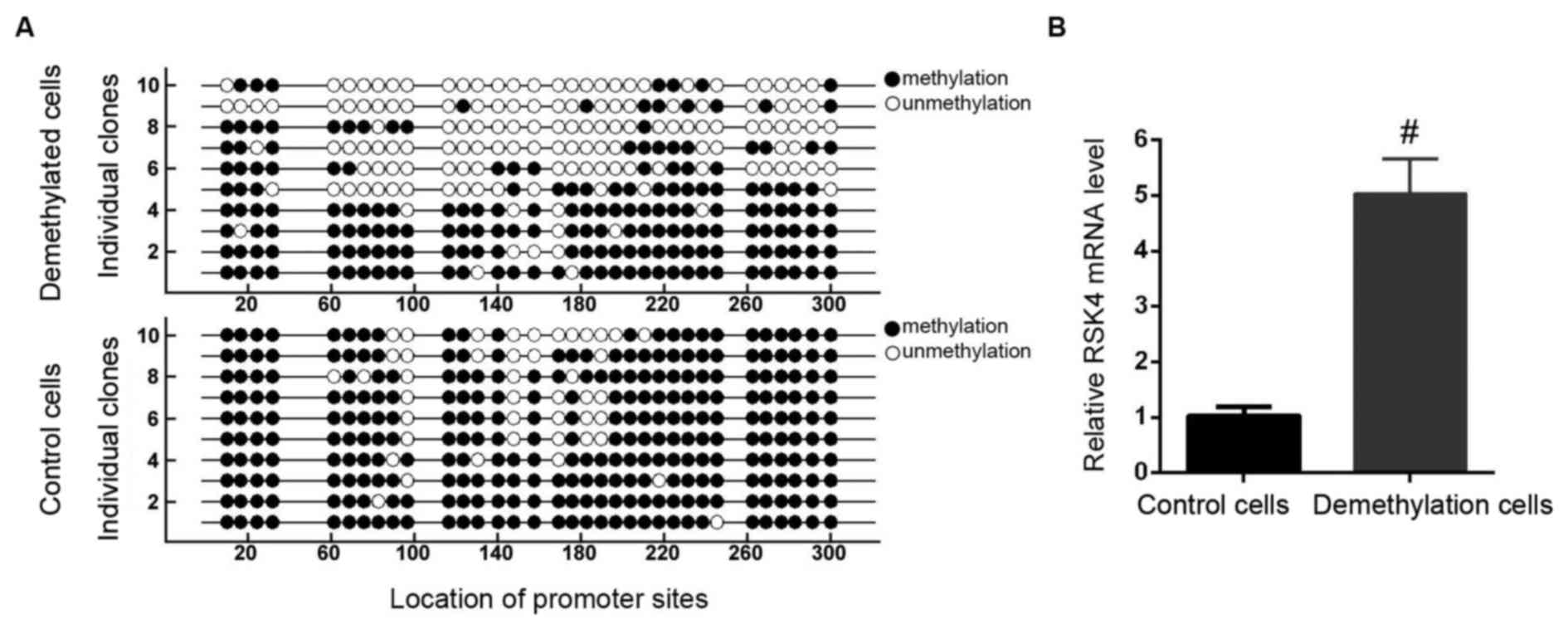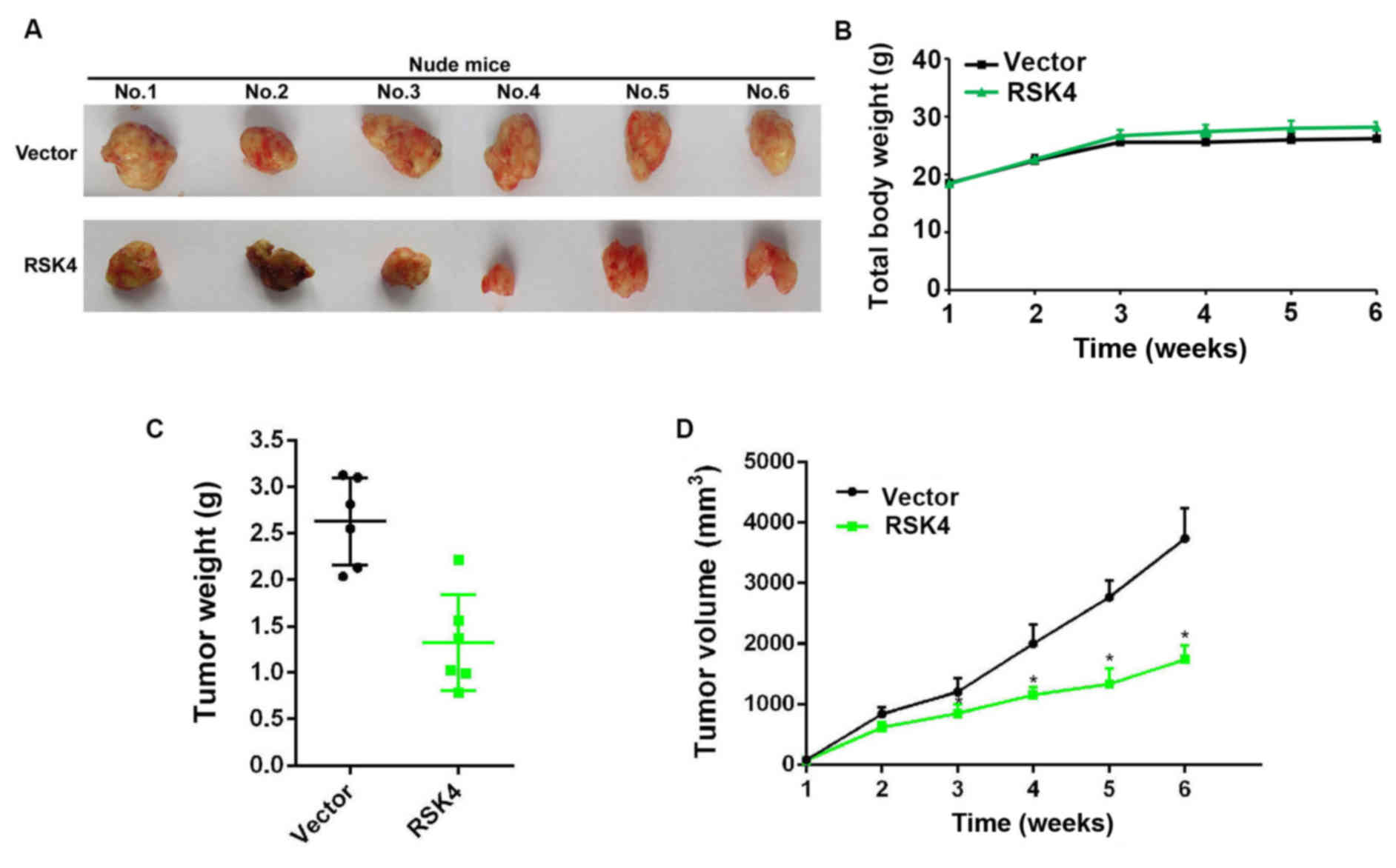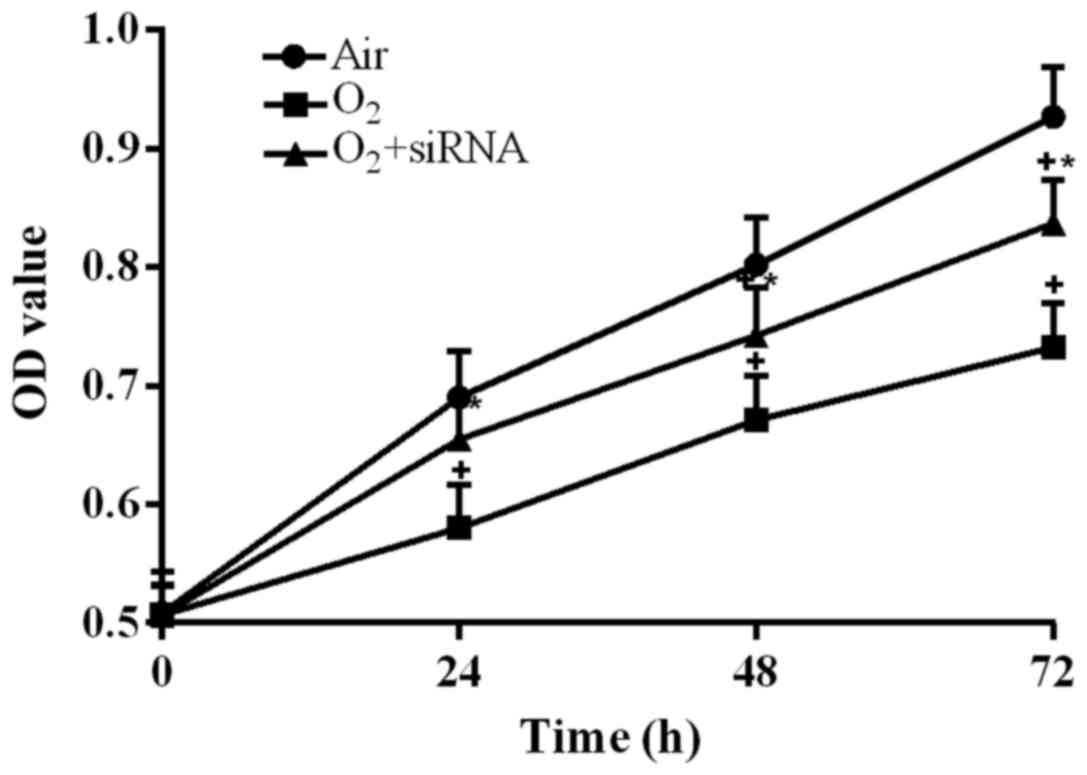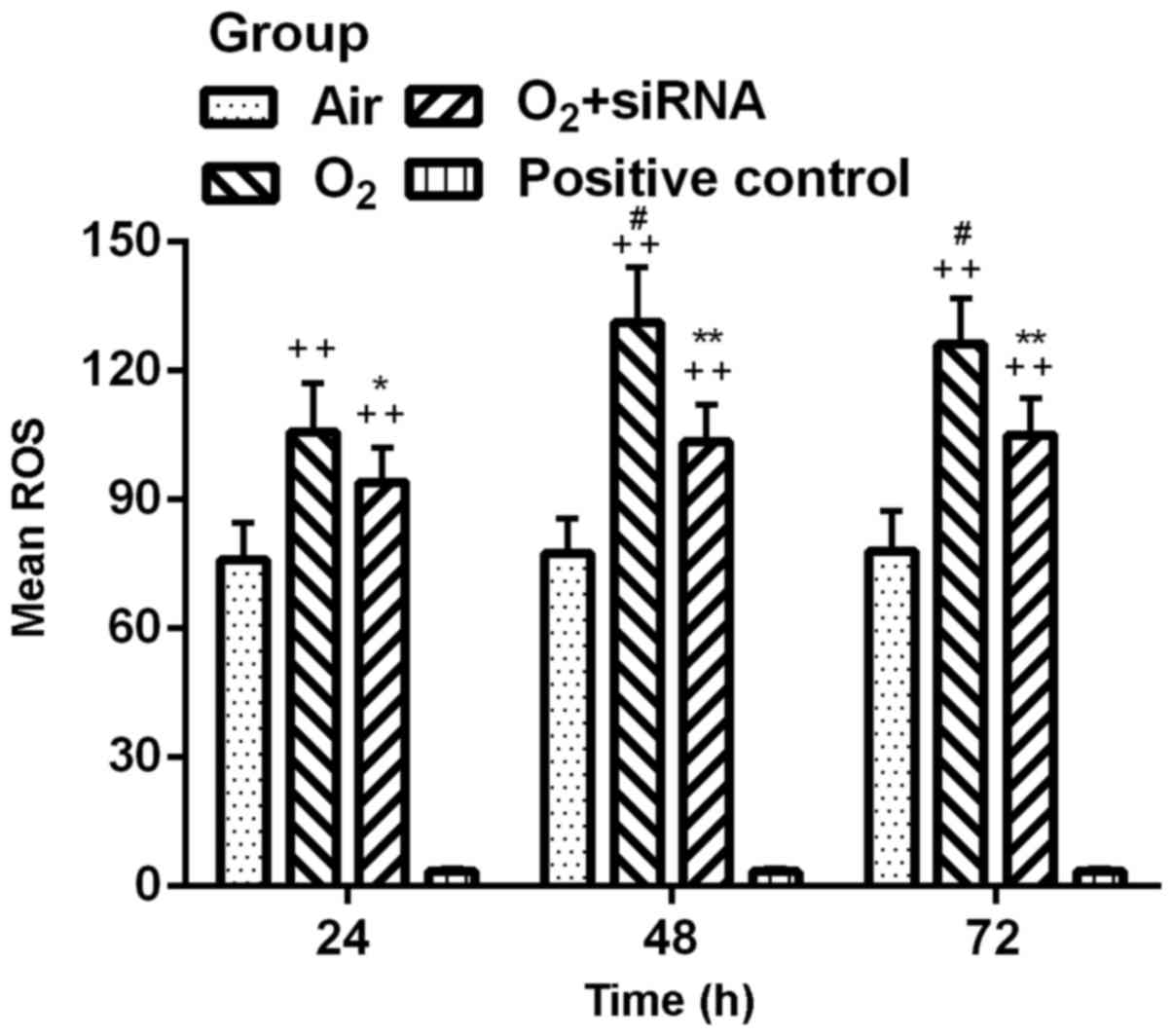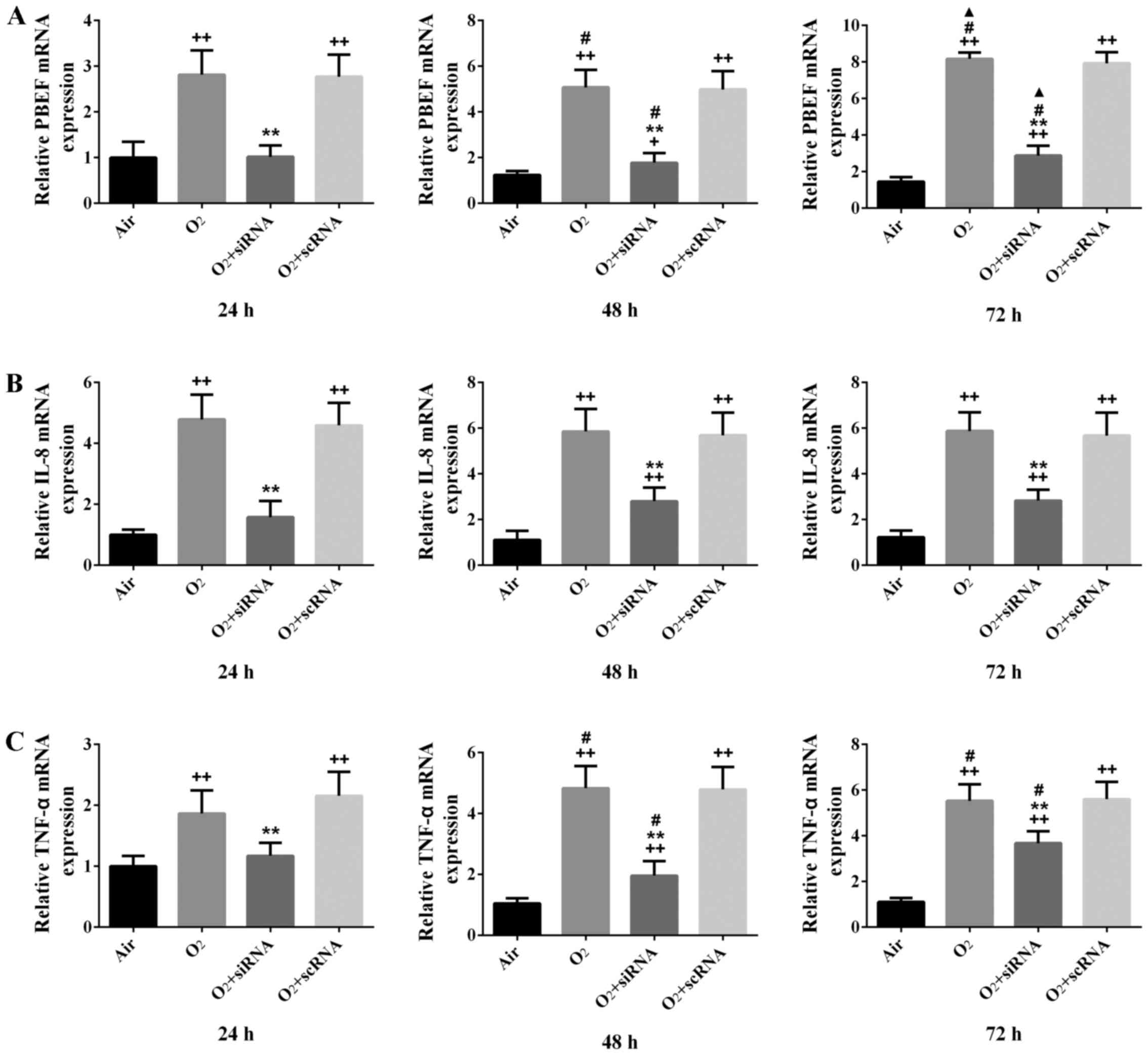Introduction
Colorectal cancer (CRC) is considered one of the
most malignant tumors affecting humans (1). The occurrence of CRC poses a serious
threat to life and thousands of individuals succumb to the disease
(2). Owing to substantial
deficiencies in healthcare and physiological conditions, only a
small fraction of patients are eligible for treatment. The onset of
CRC has continually increased over the past decades; therefore,
more and more attention has been paid to determining effective
methods for the earlier diagnosis of CRC (3). However, the overall survival rate
for patients with CRC remains low, largely due to the diagnosis
being made at a relatively late stage. Therefore, an in-depth
understanding of the underlying molecular mechanisms responsible
for the disease is of utmost importance for the early diagnosis and
potential therapeutic intervention for advanced CRC.
MicroRNAs (miRNAs or miRs) are well-characterized
short-length non-coding RNAs capable of suppressing gene expression
though base-pairing to the 3′-untranslated regions (3′-UTR) of
their targets (4,5). Increasing evidence has suggested
that miRNAs play important roles in the occurrence and development
of CRC in recent years (6,7).
Recently, miR-146 has been shown to direct the symmetric division
of spheroid-derived CRC stem cells via feedback loops in Wnt
signaling pathways (8). miR-130b
is usually downregulated in tumor tissues and inhibits CRC
progression by targeting integrin β1 (9). Zhang et al recently
identified miR-520g as a potential miRNA contributing to multi-drug
resistance (10). Further
investigation demonstrated that the effect of miR-520g was largely
mediated via the regulation of p21 expression (10). Kurihara et al recently
provided direct evidence that the expression of a polycomb group
protein named enhancer of zeste homolog 2 (EZH2) is highly
associated with the expression of miR-31, a well-known oncogenic
factor (11).
miR-582 has also been implicated in the progression
of specific cancers. For example, the decreased expression of
miR-582 has been implicated in the development of bladder cancer
and the ectopic expression of miR-582-5p can inhibit the migration
and invasion of bladder cancer cell lines (12). Another study also demonstrated
that miR-582-5p was significantly upregulated in patients with
tuberculosis and functioned as an anti-apoptotic factor (13). However, little information is
available on the exact role of miR-582 in CRC.
Phosphatase and tensin homologue deleted on
chromosome 10 (PTEN) is a tumor-suppressor gene located on
human chromosome 10q23.3, which is both a lipid phosphatase and a
protein phosphatase (14). The
inactivation of PTEN results in the constitutive activation of the
PI3K/AKT pathway with increased proliferation and survival
(15). Of note, as previously
demonstrated, the loss of PTEN may promote the progression of CRC
and PTEN can be used as a predictor of the outcome following
treatment with bevacizumab (16).
Therefore, PTEN may be critically involved in the pathogenesis of
CRC.
In the present study, we found that the expression
of miR-582 was frequently upregulated in CRC cell lines, as well as
human specimens. In addition, the overexpression of miR-582
significantly promoted the colony-forming and the migration ability
of HCT-116 cells. The adverse effects of the overexpression of
miR-582 were partially reversed by synthetic miR-582 inhibitor. The
systematic identification of miR-582 targets suggested that
PTEN may be a direct target. The expression of PTEN
transcript and protein was substantially inhibited by the
overexpression of miR-582. miR-582 also promoted tumor xenograft
growth and downregulated PTEN expression. Therefore, our
results suggest that miR-582 may serve as a putative target for
cancer intervention by dynamically regulating PTEN.
Materials and methods
Human samples and cell lines
The CRC cell lines used in the present study
(HCT-116, SW-480, SW-620, SW-948, DLD-1 and HT-29) were all
commercially obtained from the American Type Culture Collection
(ATCC; Rockville, MD, USA). The control epithelial colon cell line,
FHC, was also purchased from ATCC. These cells were cultured in
RPMI-1640 medium (Gibson, Gaithersburg, MD, USA). The medium was
supplemented with 3% fetal bovine serum (FBS) and penicillin (200
U/ml) (both from Gibson) in a humidified atmosphere 5%
CO2 at 37°C. The CRC specimens and adjacent normal
tissues (n=83) were all surgical archives from patients at the
First Affiliated Hospital, Xi'an Jiaotong University (Shaanxi,
China) obtained between October 2013 and June 2015. All specimens
were kept in liquid nitrogen at −80°C following resection prior to
use in the experiments. All patients provided formal and signed
consent forms. The protocols of the experimental procedures for the
use of human samples were formally approved by the Research Ethics
Committee of the First Affiliated Hospital, Xi'an Jiaotong
University (no. 2013H015).
Target prediction
We used algorithms for target gene prediction
TargetScan (http://genes.mit.edu/targetscan), and miRDB
(www.mirdb.org), as previously described (17,18). Briefly, putative targets were
ranked by z scores. The top ranked overlapping targets were
selected for experimental verification.
RNA extraction and reverse
transcription-quantitative PCR (RT-qPCR)
The gene expression of miR-582 and PTEN in
the CRC cells and tissues was measured by RT-qPCR. In brief, RNA
was extracted from both the CRC cells and CRC human specimens using
TRIzol reagent (Invitrogen Life Technologies, Carlsbad, CA, USA)
and reverse transcribed into cDNA using the miScript II RT kit
(Qiagen GmbH, Hilden, Germany) according to the instructions
provided by the manufacturer. The corresponding cDNA was then used
as a template for qPCR performed using the SYBR Premix Ex Taq™ kit
(Takara Bio, Inc., Otsu, Japan) according to the manufacturer's
instructions. A TaqMan miRNA qRT-PCR kit (Applied Biosystems,
Foster City, CA, USA) was applied and GAPDH was used as a control.
For PTEN detection, we used the SYBR-Green PCR Master Mix
kit (Applied Biosystems). All kinetic reactions for RT-qPCR were
carried out using the ABI Prism® 7000 Sequence Detection
System (Applied Biosystems). Relative expression was determined.
The primer sequences were as follows: PTEN forward,
5′-AGCAATGTTAAGCCGAG-3′ and reverse, 5′-TACGCCCGCACTATTGAGTAGCA-3′;
miR-582 forward, 5′-ACACTCGAGCTGGGGCTTGTTCGCTAGCATT-3′ and
reverse, 5′-TGATGCTTCTGAGTCG-3′; and GAPDH forward,
5′-CTCGATCTTCATAGCGCGTCG-3′ and reverse,
5′-ATGTCGTTCTCAGCCTTGAC-3′.
Cell line transfection
The lentiviral system to ectopically overexpress
miR-582 in the HCT-116 cell line was used in the present study. The
lentiviruses with miR-582 mimics (Lenti-miR-582) and negative
controls (Lenti-NC) were synthesized and purchased both from
Sigma-Aldrich (Shanghai, China). The miR-582 precursor, miR-582
inhibitor and the scramble control were all obtained from
Sigma-Aldrich. The pcDNA3.1-PTEN plasmids were used for
transfection. A scramble pcDNA3.1 plasmid was used as a control.
The Lipofectamine™ 2000 system (Invitrogen, Shanghai, China) was
used for viral transfection. At 24 h post-transfection, the culture
medium was replaced with fresh medium. The transfection efficiency
of all plasmids was experimentally verified by RT-qPCR.
Dual luciferase reporter assay
The recombinant psi-CHECK- rcmiR-582-WT and
psiCHECK-PTEN-3′-UTR-WT vectors were constructed by linking the
seed sequences with the 3′-UTR of PTEN or reverse complement of
miR-582 (rcmiR-582). The combined sequences were inserted into the
psi-CHECK vector. Mutant constructs were similarly obtained. The
mutation spots were indicated. The constructs were verified by DNA
sequencing. 293T cells (Institute of Biochemistry and Cell Biology,
Shanghai, China) were loaded into a 96-well plate 24 h prior to
transfection and then co-transfected with 1 µg recombinant
vectors alone or vectors with additional 20 nM precursors or
inhibitors. Transfection was carried out using the Lipofectamine™
2000 system (Invitrogen). The luciferase activities were measured
using the Dual-Luciferase reporter system (Promega, Madison, WI,
USA) as relative luciferase units following the manufacturer's
instructions.
Wound healing and migration assay
The wound healing assay was used to quantify the
migration ability of the cancer cells. The experiments were
performed as previously described (19). Briefly for wound healing assay,
the HCT-116 cells were seeded on 25-mm dishes and cultured in
RPMI-1640 medium (Gibson). A scratch with a fixed width was formed
in the cell monolayer using a 200 µl pipette tip.
Subsequently, all cells were washed twice with fresh
phosphate-buffered saline (PBS) and the suspended ones were then
removed. Wound healing was monitored and images were acquired at 0
and 48 h after the scratch was made using a bright-field microscope
(Olympus, Tokyo, Japan).
Proliferation assay
The HCT-116 cells were seeded in 96-well plates
(104 cells/well) for 5 days. The Cell Counting Kit-8
(CCK-8; Dojindo Laboratories, Kumamoto, Japan) was used. At an
interval of 24 h, the
3-(4,5-dimethylthiazol-2-yl)-2,5-diphenyltetrazolium bromide (MTT)
solution was added to the culture medium at a final concentration
of 5 mg/ml. After 6 h, the medium was removed and crystalline
formazan was dissolved in 100 µl SDS (10%; Gibson) solution
for 1 day. The optical density (OD, 490 nm) was evaluated using a
SpectraMax M5 microplate reader (Molecular Devices, Sunnyvale, CA,
USA).
Colony formation assay
The cells were trypsinized to obtain a single cell
suspension. Subsequenlty, 400 HCT-116 cells were seeded in a
12-well plate and the medium was refreshed with fresh medium every
2 days. After 6 days, the medium was discarded and the cells were
stained with crystal violet (Sigma-Aldrich, Shanghai, China) (0.2%
in 20% methanol). Images were acquired using a digital camera.
Xenograft implantation
In total, 104 HCT-116 cells transfected
with the empty vector control, lentiviral miR-582 or Lenti-NC were
injected subcutaneously into BALB/c nude mice into the right flank.
In total, 27 mice (aged 4–5 weeks; average weight, 19.6 g; males,
0; females, 27) were used. The mice were obtained from the Model
Animal Research Center (Nanjing, China). The mice were housed in an
environment with a temperature of 20°C, 55–60% humidity and a
light-dark cycle of 12 h. The access to food and water was provided
ad libitum. The protocols for the current study (no. 15-006)
were approved by the Animal Research Committee of the First
Affiliated Hospital of Xi'an Jiaotong University (Xi'an, China).
The mice were divided into 3 groups (n=8 per group) according to
the transfected cells injected. The tumor volume was measured at an
interval of 3 days for a total of 30 days. By the end of the
implantation, all mice were sacrificed.
Immunochemistry
All specimens were fixed with 15% formalin and
loaded in paraffin. The sections (2-µm-thick) were then
examined. Deparaffinized sections were then subjected to antigen
retrieval by autoclaving in 20 mmol/l citrate buffer (pH 6.0) at
120°C for 15 min. The sections were immunostained using the
Histofine stain kit (Nichirei, Tokyo, Japan). The antibody against
PTEN (Cat. no. P3487) used in this study was diluted at a ratio of
1:100 (Sigma-Aldrich). The stained sections were thyen visualized
with diaminobenzidine and counterstained with hematoxylin.
Western blot analysis
The HCT-116 cells were harvested with lysis buffer
(10% glycerol and 3% NP-40) obtained from Sigma-Aldrich. The
protein extracts (equally 100 µg for each) were dissolved in
10% SDS-PAGE and transferred onto nitrocellulose membranes (Bio-Rad
Laboratories, Inc., Hercules, CA, USA). The membranes were then
coated with monoclonal anti-PTEN (Cat. no. P3487) and anti-GAPDH
(Cat. no. G8795) antibodies (both from Sigma-Aldrich) overnight.
The HRP-conjugated secondary antibodies (1:1,000) were then added
followed by incubation at 20°C for 1.5 h. The blots were then
visualized using the chemiluminescence film system (Amersham
Pharmacia Biotech, Shanghai, China).
Statistical analysis
The results were all analyzed using SPSS version
15.0 software (SPSS, Inc., Chicago, IL, USA). All experiments were
carried out at least 3 times. P-values <0.05 were considered to
indicate statistically significant differences. A paired U test was
used for pair-wise comparisons.
Results
miR-582 is frequently upregulated in
human CRC specimens and cell lines
We aimed to determine whether miR-582 plays a role
in CRC. We compared the expression of miR-582 in 83 cases of CRC
tissues and adjacent normal tissues using RT-qPCR. The results
revealed that the miR-582 level was substantially increased in the
cancer tissues compared with the adjacent normal tissues (Fig. 1A). We also quantified the
expression of miR-582 in 6 well-characterized CRC cell lines, as
well as in a normal epithelial colon cell line. The results
revealed that miR-582 was also upregulated in the CRC cell lines
(Fig. 1B). These results
suggested that miR-582 was ubiquitously elevated in CRC in
comparison with the normal controls. The upregulation of miR-582
may also suggest that miR-582 contributes to the progression of
CRC. Since the HCT-116 cells displayed the relatively highest
expression of miR-582, we selected the HCT-116 cell line for
further in vitro analysis.
miR-582 enhances the malignant potential
of CRC cells
To verify whether miR-582 has a direct affect on CRC
cell proliferation, we transfected the HCT-116 cells with miR-582
precursor or inhibitor. The efficiency of transfection was verified
(Fig. 2A). The results of MTT
assay revealed that the overexpression of miR-582 markedly
increased cell proliferation (Fig.
2B). However, using miR-582 specific inhibitors, we found that
the adverse effects of miR-582 transfection were effectively
reversed (Fig. 2B). Subsequently,
colony formation assays were performed. The result revealed that
transfection with miR-582 precursor significantly increased the
number of colonies (Fig. 3C and
D). However, miR-582 inhibitor markedly decreased colony
formation compared with the controls (Fig. 3C and D). Finally, wound healing
assay was used to evaluate the migration ability of the CRC cells.
The results revealed that the migratory capacity of the tumor cells
was substantially enhanced following transfection with miR-582
precursor, as evidenced by the decreased wound width (Fig. 2E and F). We also confirmed the
efficacy of miR-582 inhibitor transfection owing to the significant
reduction in migration (Fig. 2E and
F). These results collectively suggest that miR-582 enhances
the proliferative and migration ability of the CRC cells.
Identification of the potential target of
miR-582
miRNAs can post-transcriptionally regulate gene
expression and exert their biological effects (20). In this study, to identify the
molecular mechanisms of action of miR-582 in CRC, we used multiple
algorithms to predict the target of miR-582 (microRNA.org, http://www.microrna.org/microrna/home.do and MIRDB,
www.mirdb.org). It was suggested that PTEN may be
a direct target. To confirm the targeting effect of miR-582,
luciferase reporters were used. Vectors containing the seed
sequences were used (3′-UTR) (Fig.
3A). The psiCHECK empty vector (negative control) and reverse
complementary miR-582 (rcmiR-582, positive control) were utilized
(Fig. 3A). The efficiencies for
positive and negative controls were verified (Fig. 3B). The results revealed that
miR-582 precursor significantly inhibit the luciferase activities
of the constructs containing PTEN 3′-UTR WT (Fig. 3C). However, the effect of miR-582
was severely reduced when the 3′-UTR of PTEN was mutated
(Fig. 3C). Moreover, miR-582 can
directly target PTEN in CRC cells, as miR-582 was found to
decrease the transcripts of PTEN (Fig. 3D). The protein level of PTEN was
also downregulated following transfection with miR-582 precursor
(Fig. 3E). Transfection with
miR-582 inhibitor reversed the effects of miR-582 on PTEN
expression at both the mRNA and protein level (Fig. 3D and E). These results thus
suggest that miR-582 directly targets PTEN for
tumorigenesis.
miR-582 targets PTEN to promote malignant
phenotypes in CRC
To further evaluate the effects of miR-582 in CRC,
we transfected the HCT-116 cells with pcDNA3.1-PTEN alone or
together with miR-582 precursor. The results revealed that
transfection with pcDNA3.1-PTEN substantially decreased the
proliferation of the HCT-116 cells (Fig. 4A). However, the effect of
pcDNA3.1-PTEN transfection was counteracted by transfection
with miR-582 precursor (Fig. 4A).
Wound healing assays also demonstrated that the migratory ability
of the HCT-116 cells was decreased by transfection with
pcDNA3.1-PTEN (Fig. 4B and
C). Consistently, transfection with miR-582 precursor promoted
cell migration (Fig. 4B and C).
However, the adverse effects of transfection with miR-582 precursor
were somehow neutralized by co-transfection with
pcDNA3.1-PTEN, as co-transfection with miR-582 precursor and
pcDNA3.1-PTEN increased cell migration compared to that
observed with transfection with pcDNA3.1-PTEN alone, but not
to the extent observed with miR-582 precursor transfection
(Fig. 4B and C). These data
suggest that miR-582 promotes the progression of CRC by directly
targeting PTEN.
miR-582 promotes tumor growth in
vivo
To further verify the effects of miR-582 in
vivo, HCT-116 cells were first transfected with empty control,
Lenti-NC or Lenti-miR-582. Subsequently, the HCT-116 cells were
subcutaneously injected into nude mice into the right flank. The
xenograft model comprised of 3 groups each containing 9 mice. The
tumor volume was monitored every 3 days. After 30 days, all mice
were sacrificed.
We found that the injection of cells transfected
with Lenti-miR-582 led to a significantly increased tumor weight
(P<0.01; Fig. 5A). Moreover,
the growth rate of the Lenti-miR-582-transfected xenografts was
also substantially increased compared with the control or Lenti-NC
groups (Fig. 5B). The level of
miR-582 was also stable at 30 days post-injection (Fig. 5C). Furthermore,
immunohisto-chemistry also confirmed a decreased PTEN expression in
the tumor xenografts formed from the Lenti-miR-582-transfected
cells (Fig. 5D). These results
demonstrate that miR-582 functions as an oncogenic factor in CRC by
targeting PTEN.
Discussion
miRNAs are a class of non-coding RNAs and are
critically involved in various biological processes (21). miRNAs can regulate tumor
occurrence and progression by directly targeting numerous genes
associated with oncogenesis, tumor suppression, proliferation or
apoptosis (22). Deregulated
miRNA expression always plays a pivotal role in tumorigenesis in
many types of cancer (23–25).
Therefore, the understanding of the association between miRNAs and
tumorigenic factors may shed light on more effective therapeutic
intervention.
A recent study demonstrated that miR-582-5p inhibits
bladder cancer progression (12).
A more recent study suggested that miR-582 targets Rab27a and
promotes tumor cell progression, although their findings were not
conclusive (26). In glioblastoma
stem cells, miR-582-5p was shown to inhibit apoptosis by targeting
caspase-9, caspase-3 and possibly Bim (27). Therefore, the exact function of
miR-582, particularly in CRC remains largely elusive. In this
study, we report that miR-582 targets PTEN and promote
tumorigenesis in CRC. Both in vitro and in vivo
experiments demonstrated that miR-582 increased the oncogenic
potential of CRC cells. The inhibition of miR-582 expression by
transfection with miR-582 inhibitor counteracted the adverse
effects of CRC cells, suggesting that targeting miR-582 may provide
a potentially effective strategy with which to annihilate malignant
tumors, particularly CRC. Notably, miRNAs can both function as
oncogenic factors or tumor suppressors in a cell type-specific
manner. For example, Jiang et al found that miR-492 promoted
tumorigenesis in hepatocarcinoma by targeting PTEN (28). However, the decreased expression
of miR-492 was also shown to contribute to oxaliplatin resistance
by increasing CD147 expression in colon cancer cell lines, implying
that miR-492 may serve as a tumor suppressor (29). These findings suggest that even
the same miRNA can play different roles under different genetic
backgrounds.
miRNA-based therapeutics have been extensively
reported in recent years. For example, the systematic delivery of
miR-34a has been proven to be effective in inhibiting lung cancer
(30). The administration of
formulated miRNAs has also been proven not to significantly affect
blood chemistry, guaranteeing the safety of miRNA delivery
(30). In addition, recent study
demonstrated that the delivery of synthetic miR-143 inhibited the
migration of osteosarcoma (31).
A number of studies have suggested that the delivery of miRNAs
alters the tumorigenic potential of various tumors (32–35). Given the role of miR-582 in the
progression of CRC, the systematic delivery of miR-582 inhibitor
may provide an alternative method with which to inhibit
tumorigenesis.
PTEN is an important tumor suppressor gene
and various miRNAs can target PTEN to regulate tumorigenesis
(28,36–38). PTEN is decreased in patients with
cancer and its deficiency is usually associated with tumorigenesis
(39). Accumulating evidence has
suggested that PTEN inhibits tumor progression by abolishing the
PI3K/AKT pathway through the dephosphorylation of PIP3 (40). Moreover, PTEN has also been
implicated in a positive feedback loop mediated through the tumor
suppressor p53 (41). In this
study, we confirmed that PTEN may be a direct target of
miR-582 via multiple strategies. Therefore, miR-582 may also
participate in the regulation of other tumor suppressor pathways
via intrinsic feedback loops. These implications may provide the
basis for designing effective miR-582 inhibitors for the targeting
of miR-582 to promote tumor suppression.
In conclusion, our study demonstrates that miR-582
promotes CRC progression and serves as an oncogenic factor.
PTEN was predicted to be the direct target of miR-582. By
regulating PTEN expression, miR-582 substantially increases
the proliferation and migration of CRC cells. Our findings suggest
that miR-582 may serve as a potential target for CRC intervention
in the future.
References
|
1
|
Böckelman C, Engelmann BE, Kaprio T,
Hansen TF and Glimelius B: Risk of recurrence in patients with
colon cancer stage II and III: a systematic review and
meta-analysis of recent literature. Acta Oncol. 54:5–16. 2015.
View Article : Google Scholar
|
|
2
|
Akiyoshi T, Kobunai T and Watanabe T:
Recent approaches to identifying biomarkers for high-risk stage II
colon cancer. Surg Today. 42:1037–1045. 2012. View Article : Google Scholar : PubMed/NCBI
|
|
3
|
Torre LA, Bray F, Siegel RL, Ferlay J,
Lortet-Tieulent J and Jemal A: Global cancer statistics, 2012. CA
Cancer J Clin. 65:87–108. 2015. View Article : Google Scholar : PubMed/NCBI
|
|
4
|
Miska EA: How microRNAs control cell
division, differentiation and death. Curr Opin Genet Dev.
15:563–568. 2005. View Article : Google Scholar : PubMed/NCBI
|
|
5
|
Cai Y, Yu X, Hu S and Yu J: A brief review
on the mechanisms of miRNA regulation. Genomics Proteomics
Bioinformatics. 7:147–154. 2009. View Article : Google Scholar
|
|
6
|
Ogata-Kawata H, Izumiya M, Kurioka D,
Honma Y, Yamada Y, Furuta K, Gunji T, Ohta H, Okamoto H, Sonoda H,
et al: Circulating exosomal microRNAs as biomarkers of colon
cancer. PLoS One. 9:e929212014. View Article : Google Scholar : PubMed/NCBI
|
|
7
|
Shivapurkar N, Weiner LM, Marshall JL,
Madhavan S, Deslattes Mays A, Juhl H and Wellstein A: Recurrence of
early stage colon cancer predicted by expression pattern of
circulating microRNAs. PLoS One. 9:e846862014. View Article : Google Scholar : PubMed/NCBI
|
|
8
|
Hwang WL, Jiang JK, Yang SH, Huang TS, Lan
HY, Teng HW, Yang CY, Tsai YP, Lin CH, Wang HW, et al:
MicroRNA-146a directs the symmetric division of Snail-dominant
colorectal cancer stem cells. Nat Cell Biol. 16:268–280. 2014.
View Article : Google Scholar : PubMed/NCBI
|
|
9
|
Zhao Y, Miao G, Li Y, Isaji T, Gu J, Li J
and Qi R: MicroRNA- 130b suppresses migration and invasion of
colorectal cancer cells through downregulation of integrin β1
[corrected]. PLoS One. 9:e879382014. View Article : Google Scholar
|
|
10
|
Zhang Y, Geng L, Talmon G and Wang J:
MicroRNA-520g confers drug resistance by regulating p21 expression
in colorectal cancer. J Biol Chem. 290:6215–6225. 2015. View Article : Google Scholar : PubMed/NCBI
|
|
11
|
Kurihara H, Maruyama R, Ishiguro K, Kanno
S, Yamamoto I, Ishigami K, Mitsuhashi K, Igarashi H, Ito M, Tanuma
T, et al: The relationship between EZH2 expression and microRNA-31
in colorectal cancer and the role in evolution of the serrated
pathway. Oncotarget. 7:12704–12717. 2016. View Article : Google Scholar : PubMed/NCBI
|
|
12
|
Uchino K, Takeshita F, Takahashi RU,
Kosaka N, Fujiwara K, Naruoka H, Sonoke S, Yano J, Sasaki H, Nozawa
S, et al: Therapeutic effects of microRNA-582-5p and -3p on the
inhibition of bladder cancer progression. Mol Ther. 21:610–619.
2013. View Article : Google Scholar : PubMed/NCBI
|
|
13
|
Liu Y, Jiang J, Wang X, Zhai F and Cheng
X: miR-582-5p is upregulated in patients with active tuberculosis
and inhibits apoptosis of monocytes by targeting FOXO1. PLoS One.
8:e783812013. View Article : Google Scholar : PubMed/NCBI
|
|
14
|
Saal LH, Gruvberger-Saal SK, Persson C,
Lövgren K, Jumppanen M, Staaf J, Jönsson G, Pires MM, Maurer M,
Holm K, et al: Recurrent gross mutations of the PTEN tumor
suppressor gene in breast cancers with deficient DSB repair. Nat
Genet. 40:102–107. 2008. View Article : Google Scholar
|
|
15
|
Di Cristofano A and Pandolfi PP: The
multiple roles of PTEN in tumor suppression. Cell. 100:387–390.
2000. View Article : Google Scholar : PubMed/NCBI
|
|
16
|
Price TJ, Hardingham JE, Lee CK, Townsend
AR, Wrin JW, Wilson K, Weickhardt A, Simes RJ, Murone C and Tebbutt
NC: Prognostic impact and the relevance of PTEN copy number
alterations in patients with advanced colorectal cancer (CRC)
receiving bevacizumab. Cancer Med. 2:277–285. 2013. View Article : Google Scholar : PubMed/NCBI
|
|
17
|
Lewis BP, Shih IH, Jones-Rhoades MW,
Bartel DP and Burge CB: Prediction of mammalian microRNA targets.
Cell. 115:787–798. 2003. View Article : Google Scholar : PubMed/NCBI
|
|
18
|
Wong N and Wang X: miRDB: an online
resource for microRNA target prediction and functional annotations.
Nucleic Acids Res. 43:D146–152. 2015. View Article : Google Scholar :
|
|
19
|
Han XJ, Yang ZJ, Jiang LP, Wei YF, Liao
MF, Qian Y, Li Y, Huang X, Wang JB, Xin HB, et al: Mitochondrial
dynamics regulates hypoxia-induced migration and antineoplastic
activity of cisplatin in breast cancer cells. Int J Oncol.
46:691–700. 2015.
|
|
20
|
Cheng CJ, Bahal R, Babar IA, Pincus Z,
Barrera F, Liu C, Svoronos A, Braddock DT, Glazer PM, Engelman DM,
et al: MicroRNA silencing for cancer therapy targeted to the tumour
microenvironment. Nature. 518:107–110. 2015. View Article : Google Scholar
|
|
21
|
Garofalo M and Croce CM: Role of microRNAs
in maintaining cancer stem cells. Adv Drug Deliv Rev. 81:53–61.
2015. View Article : Google Scholar :
|
|
22
|
Di Leva G, Garofalo M and Croce CM:
MicroRNAs in cancer. Annu Rev Pathol. 9:287–314. 2014. View Article : Google Scholar :
|
|
23
|
Lim EL, Trinh DL, Scott DW, Chu A,
Krzywinski M, Zhao Y, Robertson AG, Mungall AJ, Schein J, Boyle M,
et al: Comprehensive miRNA sequence analysis reveals survival
differences in diffuse large B-cell lymphoma patients. Genome Biol.
16:182015. View Article : Google Scholar : PubMed/NCBI
|
|
24
|
Yang Y, Xing Y, Liang C, Hu L, Xu F and
Chen Y: Crucial microRNAs and genes of human primary breast cancer
explored by microRNA-mRNA integrated analysis. Tumour Biol.
36:5571–5579. 2015. View Article : Google Scholar : PubMed/NCBI
|
|
25
|
Hata A and Kashima R: Dysregulation of
microRNA biogenesis machinery in cancer. Crit Rev Biochem Mol Biol.
51:121–134. 2015. View Article : Google Scholar : PubMed/NCBI
|
|
26
|
Zhang X, Zhang Y, Yang J, Li S and Chen J:
Upregulation of miR-582-5p inhibits cell proliferation, cell cycle
progression and invasion by targeting Rab27a in human colorectal
carcinoma. Cancer Gene Ther. 22:475–480. 2015. View Article : Google Scholar : PubMed/NCBI
|
|
27
|
Floyd DH, Zhang Y, Dey BK, Kefas B, Breit
H, Marks K, Dutta A, Herold-Mende C, Synowitz M, Glass R, et al:
Novel anti-apoptotic microRNAs 582-5p and 363 promote human
glioblastoma stem cell survival via direct inhibition of caspase 3,
caspase 9, and Bim. PLoS One. 9:e962392014. View Article : Google Scholar
|
|
28
|
Jiang J, Zhang Y, Yu C, Li Z, Pan Y and
Sun C: MicroRNA-492 expression promotes the progression of hepatic
cancer by targeting PTEN. Cancer Cell Int. 14:952014. View Article : Google Scholar : PubMed/NCBI
|
|
29
|
Peng L, Zhu H, Wang J, Sui H, Zhang H, Jin
C, Li L, Xu T and Miao R: miR-492 is functionally involved in
oxaliplatin resistance in colon cancer cells LS174T via its
regulating the expression of CD147. Mol Cell Biochem. 405:73–79.
2015. View Article : Google Scholar : PubMed/NCBI
|
|
30
|
Wiggins JF, Ruffino L, Kelnar K, Omotola
M, Patrawala L, Brown D and Bader AG: Development of a lung cancer
therapeutic based on the tumor suppressor microRNA-34. Cancer Res.
70:5923–5930. 2010. View Article : Google Scholar : PubMed/NCBI
|
|
31
|
Shimbo K, Miyaki S, Ishitobi H, Kato Y,
Kubo T, Shimose S and Ochi M: Exosome-formed synthetic microRNA-143
is transferred to osteosarcoma cells and inhibits their migration.
Biochem Biophys Res Commun. 445:381–387. 2014. View Article : Google Scholar : PubMed/NCBI
|
|
32
|
Tivnan A, Orr WS, Gubala V, Nooney R,
Williams DE, McDonagh C, Prenter S, Harvey H, Domingo-Fernández R,
Bray IM, et al: Inhibition of neuroblastoma tumor growth by
targeted delivery of microRNA-34a using anti-disialoganglioside
GD2 coated nanoparticles. PLoS One. 7:e381292012.
View Article : Google Scholar
|
|
33
|
Wang H, Jiang Y, Peng H, Chen Y, Zhu P and
Huang Y: Recent progress in microRNA delivery for cancer therapy by
non-viral synthetic vectors. Adv Drug Deliv Rev. 81:142–160. 2015.
View Article : Google Scholar
|
|
34
|
Kosaka N, Takeshita F, Yoshioka Y,
Hagiwara K, Katsuda T, Ono M and Ochiya T: Exosomal
tumor-suppressive microRNAs as novel cancer therapy: 'exocure' is
another choice for cancer treatment. Adv Drug Deliv Rev.
65:376–382. 2013. View Article : Google Scholar
|
|
35
|
Guo X, Zhang J, Pang J, He S, Li G, Chong
Y, Li C, Jiao Z, Zhang S and Shao M: MicroRNA-503 represses
epithelial-mesenchymal transition and inhibits metastasis of
osteosarcoma by targeting c-myb. Tumour Biol. 37:9181–9187. 2016.
View Article : Google Scholar : PubMed/NCBI
|
|
36
|
Chun-Zhi Z, Lei H, An-Ling Z, Yan-Chao F,
Xiao Y, Guang-Xiu W, Zhi-Fan J, Pei-Yu P, Qing-Yu Z and Chun-Sheng
K: MicroRNA-221 and microRNA-222 regulate gastric carcinoma cell
proliferation and radioresistance by targeting PTEN. BMC Cancer.
10:3672010. View Article : Google Scholar : PubMed/NCBI
|
|
37
|
Ma J, Liu J, Wang Z, Gu X, Fan Y, Zhang W,
Xu L, Zhang J and Cai D: NF-kappaB-dependent microRNA-425
upregulation promotes gastric cancer cell growth by targeting PTEN
upon IL-1β induction. Mol Cancer. 13:402014. View Article : Google Scholar
|
|
38
|
Zhang AX, Lu FQ, Yang YP, Ren XY, Li ZF
and Zhang W: MicroRNA-217 overexpression induces drug resistance
and invasion of breast cancer cells by targeting PTEN signaling.
Cell Biol Int. Jun 24–2015.Epub ahead of print. View Article : Google Scholar
|
|
39
|
Tang JM, He QY, Guo RX and Chang XJ:
Phosphorylated Akt overexpression and loss of PTEN expression in
non-small cell lung cancer confers poor prognosis. Lung Cancer.
51:181–191. 2006. View Article : Google Scholar
|
|
40
|
Feng B, Zhang K, Wang R and Chen L:
Non-small-cell lung cancer and miRNAs: novel biomarkers and
promising tools for treatment. Clin Sci (Lond). 128:619–634. 2015.
View Article : Google Scholar
|
|
41
|
Harris SL and Levine AJ: The p53 pathway:
positive and negative feedback loops. Oncogene. 24:2899–2908. 2005.
View Article : Google Scholar : PubMed/NCBI
|















